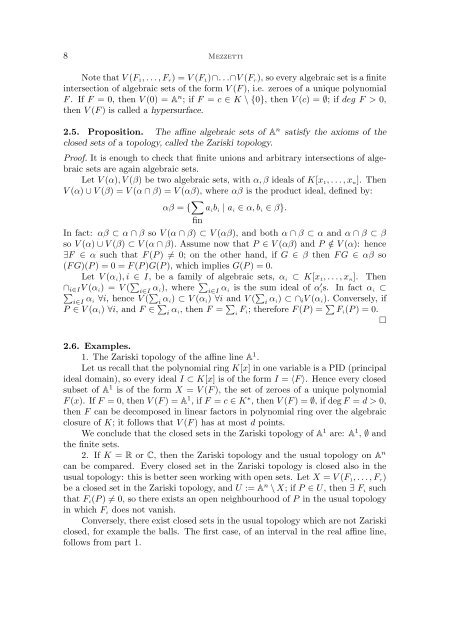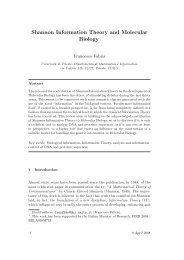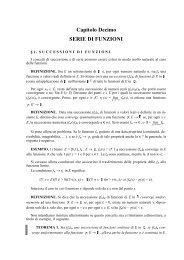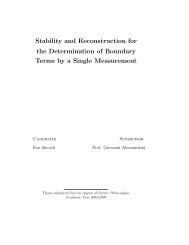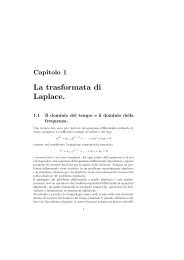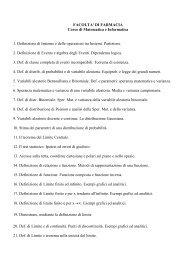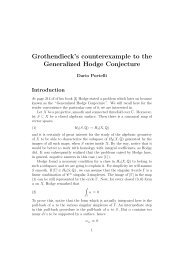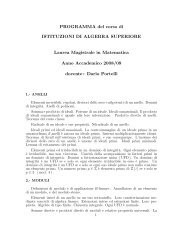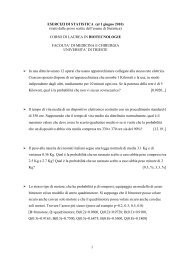INTRODUCTION TO ALGEBRAIC GEOMETRY Note del corso di ...
INTRODUCTION TO ALGEBRAIC GEOMETRY Note del corso di ...
INTRODUCTION TO ALGEBRAIC GEOMETRY Note del corso di ...
Create successful ePaper yourself
Turn your PDF publications into a flip-book with our unique Google optimized e-Paper software.
8 Mezzetti<strong>Note</strong> that V (F 1 , . . ., F r ) = V (F 1 )∩. . .∩V (F r ), so every algebraic set is a finiteintersection of algebraic sets of the form V (F), i.e. zeroes of a unique polynomialF. If F = 0, then V (0) = A n ; if F = c ∈ K \ {0}, then V (c) = ∅; if deg F > 0,then V (F) is called a hypersurface.2.5. Proposition. The affine algebraic sets of A n satisfy the axioms of theclosed sets of a topology, called the Zariski topology.Proof. It is enough to check that finite unions and arbitrary intersections of algebraicsets are again algebraic sets.Let V (α), V (β) be two algebraic sets, with α, β ideals of K[x 1 , . . ., x n ]. ThenV (α) ∪ V (β) = V (α ∩ β) = V (αβ), where αβ is the product ideal, defined by:αβ = { ∑ a i b i | a i ∈ α, b i ∈ β}.finIn fact: αβ ⊂ α ∩ β so V (α ∩ β) ⊂ V (αβ), and both α ∩ β ⊂ α and α ∩ β ⊂ βso V (α) ∪ V (β) ⊂ V (α ∩ β). Assume now that P ∈ V (αβ) and P /∈ V (α): hence∃F ∈ α such that F(P) ≠ 0; on the other hand, if G ∈ β then FG ∈ αβ so(FG)(P) = 0 = F(P)G(P), which implies G(P) = 0.Let V (α i ), i ∈ I, be a family of algebraic sets, α i ⊂ K[x 1 , . . ., x n ]. Then∩ i∈I V (α i ) = V ( ∑ i∈I α i), where ∑ i∈I α i is the sum ideal of α ′ s. In fact α i i∑⊂i∈I α i ∀i, hence V ( ∑ i α i) ⊂ V (α i ) ∀i and V ( ∑ i α i) ⊂ ∩ i V (α i ). Conversely, ifP ∈ V (α i ) ∀i, and F ∈ ∑ i α i, then F = ∑ F i i; therefore F(P) = ∑ F i (P) = 0.□2.6. Examples.1. The Zariski topology of the affine line A 1 .Let us recall that the polynomial ring K[x] in one variable is a PID (principalideal domain), so every ideal I ⊂ K[x] is of the form I = 〈F 〉. Hence every closedsubset of A 1 is of the form X = V (F), the set of zeroes of a unique polynomialF(x). If F = 0, then V (F) = A 1 , if F = c ∈ K ∗ , then V (F) = ∅, if deg F = d > 0,then F can be decomposed in linear factors in polynomial ring over the algebraicclosure of K; it follows that V (F) has at most d points.We conclude that the closed sets in the Zariski topology of A 1 are: A 1 , ∅ andthe finite sets.2. If K = R or C, then the Zariski topology and the usual topology on A ncan be compared. Every closed set in the Zariski topology is closed also in theusual topology: this is better seen working with open sets. Let X = V (F 1 , . . ., F r )be a closed set in the Zariski topology, and U := A n \ X; if P ∈ U, then ∃ F i suchthat F i (P) ≠ 0, so there exists an open neighbourhood of P in the usual topologyin which F i does not vanish.Conversely, there exist closed sets in the usual topology which are not Zariskiclosed, for example the balls. The first case, of an interval in the real affine line,follows from part 1.


